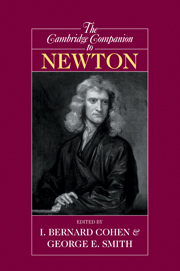Book contents
- Frontmatter
- Introduction
- 1 Newton's philosophical analysis of space and time
- 2 Newton's concepts of force and mass, with notes on the Laws of Motion
- 3 Curvature in Newton's dynamics
- 4 The methodology of the Principia
- 5 Newton's argument for universal gravitation
- 6 Newton and celestial mechanics
- 7 Newton's optics and atomism
- 8 Newton's metaphysics
- 9 Analysis and synthesis in Newton's mathematical work
- 10 Newton, active powers, and the mechanical philosophy
- 11 The background to Newton's chymistry
- 12 Newton's alchemy
- 13 Newton on prophecy and the Apocalypse
- 14 Newton and eighteenth-century Christianity
- 15 Newton versus Leibniz: from geometry to metaphysics
- 16 Newton and the Leibniz-Clarke correspondence
- Bibliography
- Index
6 - Newton and celestial mechanics
Published online by Cambridge University Press: 28 May 2006
- Frontmatter
- Introduction
- 1 Newton's philosophical analysis of space and time
- 2 Newton's concepts of force and mass, with notes on the Laws of Motion
- 3 Curvature in Newton's dynamics
- 4 The methodology of the Principia
- 5 Newton's argument for universal gravitation
- 6 Newton and celestial mechanics
- 7 Newton's optics and atomism
- 8 Newton's metaphysics
- 9 Analysis and synthesis in Newton's mathematical work
- 10 Newton, active powers, and the mechanical philosophy
- 11 The background to Newton's chymistry
- 12 Newton's alchemy
- 13 Newton on prophecy and the Apocalypse
- 14 Newton and eighteenth-century Christianity
- 15 Newton versus Leibniz: from geometry to metaphysics
- 16 Newton and the Leibniz-Clarke correspondence
- Bibliography
- Index
Summary
Newton's achievements in celestial mechanics tend in popular accounts to be underestimated in some respects, exaggerated in others. This chapter seeks to correct a number of misconceptions arising from inattention to the detailed history.
KEPLER’S FIRST TWO LAWS, SO-CALLED, AND NEWTON
The claim that the planets move in elliptical orbits, with the radii vectores from Sun to planet sweeping out equal areas in equal times, first appeared in Kepler’s Astronomia Nova of 1609. Since the late eighteenth century the two parts of this claim have been referred to as Kepler’s first two planetary “laws,” understood as empirical laws. According to the popular account, Newton relied on these “laws” as thus established.
Writing to Halley on 20 June 1686, Newton stated: “Kepler knew ye Orb to be not circular but oval & guest it to be elliptical.” Whether Newton ever saw the Astronomia Nova is unknown.
The Astronomia Nova is an innovative work. It establishes important empirical results, such as the passage of the planet’s orbital plane through the Sun’s center and the orbit’s oval shape. Was the orbit’s ellipticity also a straightforwardly empirical result, say by means of triangulations of Mars, as sometimes asserted? Kepler carried out many such triangulations, but they were subject to sizeable observational error, of which he was acutely aware.
- Type
- Chapter
- Information
- The Cambridge Companion to Newton , pp. 202 - 226Publisher: Cambridge University PressPrint publication year: 2002
- 5
- Cited by



